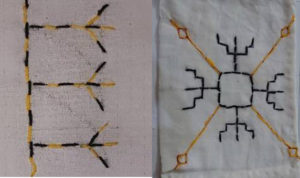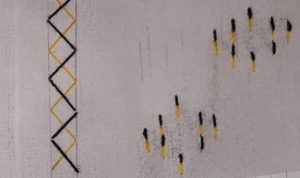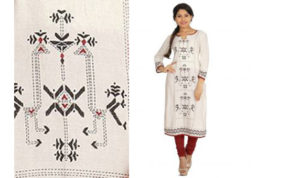By,
Riya Tyagi (Student)
B.Design (Textile Design)
Satyam Fashion Institute
Kasuti is a style of embroidery that has caught the world unaware, the kasuti style of Dharwad sarees are indeed mystic. A style that has found its origins in the seven scenic hills, kasuti is a hand-woven variety of embroidery. Basically, found in the Silk pallus, Kasuti embroidery consists of interwoven geometric patterns that make up for this interesting design. It has mostly been adapted from the temple designs and architectural musings of the surroundings.

 Image: Stitches of Kasuti – In two colours for understanding the technique of creating reversible designs
Image: Stitches of Kasuti – In two colours for understanding the technique of creating reversible designs
This style originated way back in the 7th century in the lands of Western Karnataka in the regions of Dharwad. This is the real source of the name Dharwad Sarees The name has a very kannada feel to it with Kai’ meaning hand and Suti’ meaning Cotton to make up for Kasuti embroidery which literally means handwork of Cotton thread. This embroidery pattern found its source in the Ikal sarees, a variety of cotton sarees found in the regions of Ikal. The tradition followed was to gift a bride a blue embroidered Cotton Saree. These patterns are close folded and, formed out of four stitches known as gavanti, muragi, nevgi and menthe. These stitches are completely based on the thread count method and are equidistant. Today, this embroidery is no longer just prevalent in sarees. One can find fine traces of this embroidery in salwar suits and dress materials as well. Employing various kasuti weavers by bringing in the tradition of this embroidery in sarees and dress materials gives out a splendid present time for the Dharwad sarees. The materials are not limited to Cotton anymore. They have started ranging from Silk to other varieties including Nylon.

Kasuti embroidery is believed to have originated from north Karnataka which spread all over the region. There are literary references which date back to 15th century. Every woman was expected to adorn her sari and blouse with Kasuti embroidery. The history of Kasuti dates back to the Chalukyaperiod.Mirror work embroidery and gold and silver thread embroidery were mostly used for special occasions like weddings. Sarees embroidered with Kasuti were expected to be a part of the bridal trousseau of which one saree made of black silk with Kasuti embroidery called Chandrakali saree was of premier importance
Latest Innovations
Kasuti embroidery has now spread to furniture covers and splendid curtains also. The rustic motifs are an interesting version of the kasuti embroidery that has driven the innovations in. With classic designs and beautiful embroidery, kasuti gives out an amazing collection of furniture wear.
Key words: Kasuti, Dharwad, Sarees, Karnataka, Cotton